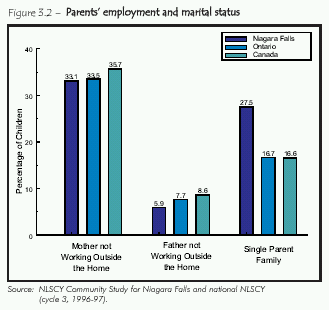
| Français | Contact Us | Help | Search | Canada Site |
| About Us | Services Where You Live | Policies & Programs | A-Z Index | Home |

Understanding the Early Years Early Childhood Development in Niagara Falls, Ontario - June 2003 |
|
|
|
|
Services for:
|
III. How family background affects children's preparedness for a good start in life
| Previous | Contents | Next |
In this section, information about the relationship between family background and children's outcomes is presented, and the family background of the children in Niagara Falls is described. The relationship between family background and children's outcomes is not straightforward. An important goal of Understanding the Early Years is to distinguish the effects of family background, and those associated with family processes and community factors on children's outcomes. All three sets of contributing factors were measured. First, information on eight characteristics of family background are presented. In an earlier study of children's development, based on the national sample of children who participated in the first cycle of the NLSCY, these family background characteristics were significantly related to a range of children's developmental outcomes.
The values, calculated for the eight family background characteristics, are:
- Family income (in $10,000 units): considered to be low if less than $25,000;
- Mother's level of education: considered to be low if the mother did not complete high school;
- Father's level of education: considered to be low if the father did not complete high school;
- Mother's employment status: considered not working outside the home if the mother worked fewer than 25 weeks during the past year;
- Father's employment status: considered not working outside the home if the father worked fewer than 25 weeks during the past year;
- Single-parent family: only one parent or guardian living at home;
- Number of brothers and sisters: the number of siblings living at home.
Figures 3.1 and 3.2 show the relative levels of income, education, employment, and single-parenthood for families in the community, as well as provincial, and national levels for 1996/97. About 25.7% of families in Niagara Falls were considered low income, compared with about 19.9% in Ontario and 22% in Canada.
About 90% of the children's mothers and fathers had completed high school. Compared with provincial and national averages (86.9% and 86.3% completion rates respectively), mothers in Niagara Falls had relatively high levels of education (88.7% completion rate). For fathers, the completion rate of 90.4% is also above the provincial and national rates (85% and 83.5% respectively).
Almost 28% of families were headed by a single parent, much more than the provincial average of 16.7% or the national average of 16.6%.
Unemployment levels in Niagara Falls were similar to provincial and national averages for mothers, and lower for fathers. About 67% of mothers were working outside the home, compared with about 67% provincially and 64% nationally. Likewise, 94% of men were working outside the home, compared with 92% provincially and 91% nationally.


The most striking demographic difference associated with Niagara Falls families is the high percentages of single-parent families. Only about 73% of the children in Niagara Falls were in two-parent families, while provincial and national figures are above 80%.
The map describing the socio-economic status of Niagara Falls families (Figure 1.1) indicated that most EAs in this community are of middle- to low-SES. The few high SES EAs did not score dramatically better on the EDI outcomes, as shown by the maps in Figures 2.3 to 2.7. Therefore, in Niagara Falls, socio-economic and demographic factors alone do not explain why some children are better prepared in their cognitive and behavioural skills when they enter school.
A. The effects of family background factors on children's development
The analysis focused on the factors contributing to whether or not a child had significantly low scores in one of the three developmental domains, these being the cognitive domain, the behavioural domain, and physical health and well-being. Children with very low scores are at risk of not achieving their full potential during the schooling years.
A child was considered to be at risk in the cognitive domain if he or she had a low score (i.e., below the 10% threshold) on the Receptive Language Test, the Developmental Assessment (Who Am I ?), or on the two cognitive domains of the Early Development Instrument.
Similarly, a child was considered at risk in the behavioural domain if he or she had a low score on the Positive Behaviour scale or on either of the two domains of the EDI pertaining to behaviour, or had any one of the four behaviour problems (indirect aggression, hyperactivity, emotional disorder/anxiety, and physical aggression/conduct disorder).
A child was considered at risk in the physical health domain if he or she scored below the low-score threshold on the Physical Health and Well-being domain of the EDI.
The analysis below focuses on positive outcomes, that is, it asks whether children will have a ''good start in life''. Children who are not vulnerable in any of the three domains are likely to have a better chance of achieving their full potential during the schooling years. Therefore, for each of the family background factors, the odds-ratio associated with whether a child was not at risk in these three domains was estimated (see Table 3.1) using the sample of children from all seven of the 2001-02 UEY communities. Thus, the results indicated in Table 3.1 apply to all 2001-02 communities, and are not specific to Niagara Falls.
| Children's Outcomes | |||
| Cognitive | Behavioural | Physical Health & Well-being | |
| Family Income ($10,000 units) | 1.07 | 1.04 | 1.12 |
| Mother's Education (years) | 1.11 | 1.02 | 1.08 |
| Father's Education (years) | 1.08 | 1.03 | 1.12 |
| Mother Not Working Outside the Home | 0.71 | 0.93 | 0.78 |
| Father Not Working Outside the Home | 0.58 | 0.92 | 0.83 |
| Single-Parent Family | 0.73 | 0.71 | 0.65 |
| Number of Brothers and Sisters | 0.92 | 0.93 | 0.92 |
| Source: Figures in blue text are statistically significant at p<.10. Results are based on the relationship of NLSCY family background variables with three readiness outcomes for the 7 UEY communities. | |||
Odds-ratios denote the ratio of the odds of an event occurring after a one-unit change in the independent variable, compared with what it had been previously, if all other independent variables in the model are held constant.
For example, suppose the outcome variable of interest was whether a child repeated Grade 1. If the odds ratio for mother's education were .95, it would indicate that the odds of a child repeating a grade decreases as his or her mother's level of education increases. Specifically, with an increase of one year of the mother's education (e.g., 11 to 12, or 12 to 13, etc.), the odds of a child repeating a grade decreases by 5%. When an odds-ratio is greater than 1.0, it indicates that the odds of experiencing the outcome (e.g., repeating Grade 1) are greater with increasing levels of the factor being considered.
The results indicate that family income and the educational level of the mother are important protective factors for cognitive development.
For example, the odds of being not at risk in the cognitive domain for a child living in a family with an income of $40,000 is about 7% greater than a child who had similar background characteristics but had a family income of $30,000. Similarly, each additional year of education of a child's mother or father increases the odds of not being at risk in the cognitive domain by about 8% to 11%.
In contrast, children whose parents were not working outside the home were more likely to be at risk in the cognitive domain, as were children living in single-parent families. The effects of these factors were considerable: each was associated with an increase in the odds of being at risk by about 29% to 42%.
The effects of family background for the behavioural domain were consistent with the effects for cognitive development, but they were generally weaker and not statistically significant. The exception was living in a single-parent family. Children from single-parent families were on average about 29% more likely to be at risk.
These effects of family income and father's education were similar for children's physical health and well-being: a $10,000 increase in family income was associated with a 12% decrease in the odds of being at risk, and each additional year of father's education was associated with a 12% decrease in the odds of being at risk. The other family background effects were not statistically significant.
These findings pertain to the relationships among developmental outcomes and family background for all families and children who participated in the seven UEY 2001-02 community studies. It is important to note that not all children in low income or single-parent families have poor developmental outcomes. Some children from low-income or single-parent families have average or above-average scores on the outcome measures used in the study. Similarly, there are some children from high-income families, and families with two parents, who did not fare well on the developmental measures. Thus, the relationships observed only indicate that a child is more likely to experience difficulties in these developmental domains if he or she is from a poor family or a single parent family.
Given these relationships between children's outcomes in these domains and family income and maternal education, and the relatively high prevalence of families with low income, the relatively strong performance of the children on some outcomes is a positive surprise. It appears that the higher levels of parental education are protective factors. The results in Table 3.1 also indicate that the prevalence of hyperactive children is higher among single-parent families. Niagara Falls has an especially high percentage of single parent families, which may account to some extent for the relatively high prevalence of hyperactive children in this community. However, it is likely that other aspects of family and community life have also influenced children's outcomes. We examine these factors in the next section.
| Previous | Contents | Next |
| Last modified : 2005-01-11 | top | Important Notices |